Many of us think of mushroom season as being in the Fall. While the majority of our dinnertime favourites fruit in Autumn, mushrooms of one kind or another can be found all year round, if you look closely!
In this post, we’ll be looking at some common mushrooms that fruit in the Spring and early Summer here in the Pacific Northwest.
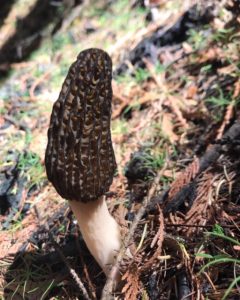
A morel growing in a burn site
1. Morel (Morchella spp.) Many would consider morels the primary goal of Spring mushroom hunting. Morels are prized for their culinary excellence, and of course, their elusiveness. Mushrooms with long-term myccorhizae (plant – fungi relationships) can fruit year after year in the same place, and often associate with a certain species of tree, or thrive in certain biomes, which makes them a bit easier to track down. Morels on the other hand, don’t stick around more than 1 or 2 years in the same place, so even once you find some, you are not likely to find them again. They can be found April through July, typically arising in disturbed areas such as garden beds, and most famously, past wildfire sites.
Caution: Always cook morels thoroughly. Raw morels contain a toxin that can cause gastro-intestinal distress. In addition, many people find consuming alcohol and morels in the same meal also creates GI distress. I frequently enjoy wine with my morel pasta so I know it doesn’t affect everyone. As with all wild mushrooms, proceed with caution, and don’t try a new species the day before going on a hot date or important event!
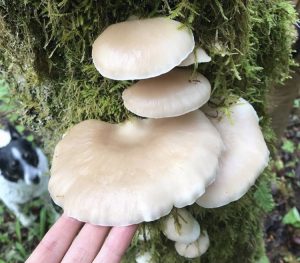
Spring Oyster Mushrooms – photo by @forage.vanisle
2. Spring Oyster Mushrooms (Pleurotus ostreatus) are another Spring favourite. Similar to the cultivated oyster mushroom, but in my opinion, incomparably better. There is a similar species called “Angel Wings” (Pleurotus porrigens) that was up until recently widely considered edible and choice. However, several deaths were linked to it in 2004, causing reconsideration. I have friends who eat them anyways and love them. If you are worried about telling them apart, the biggest clue is: Angel Wings fruit in the Fall, and Spring Oysters fruit in the Spring. There is a species of oyster mushroom that fruits in the fall, but it looks significantly different, having greyish/brown/green colouration. My favourite way to enjoy these is to marinate in garlic, parsley, olive oil, lemon, salt & pepper before gently sauteeing, baking, or grilling and adding to pasta, risotto, or on a burger.
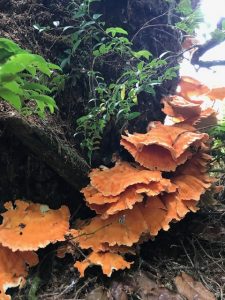
Chicken of the Woods
3. Chicken of the Woods (In our area there are two species, both edible, Laetiporus conifericola & L. gilbertsonii), is one of the most visually striking Spring mushrooms. When young, they really do have the texture of chicken! When old, they have the texture of chalk. They can be found growing on conifers (L. conifericola), and hardwood trees (L. gilbertsonii) living or dead. Harvest younger specimens (leave the babies!) and the outer 2″ of mature specimens, taking the most tender part and leaving the rest to continue releasing spores. Cook well, (I recommend adding them to a risotto), and use caution – some cases of intestinal distress/allergies/bad results have been reported when consumed with alcohol
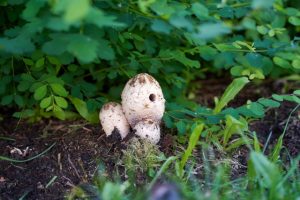
Young Shaggy Manes, photo courtesy of Rob Dumont
4. Shaggy Mane (Coprinus comatus). These are wonderful for beginners because they are easy to identify and are often seen in Vancouver’s parks, boulevards, university campuses, and other grassy urban areas. I wouldn’t recommend harvesting from urban areas due to the potential of contamination, but for identification practice only. Due to their delicate texture, they aren’t suitable in many recipes you would use button mushrooms, such as omelettes. They require intention and creativity. Harvest young, firm specimens that have not become “inky”. Ensure you identify a patch in all stages to confirm ID. There are mushrooms in this genus with unknown/questionable edibility, namely C. lagopus and C. atramentaria. This chef is amazing, although I haven’t tried this recipe specifically: https://foragerchef.com/parmesan-crusted-shaggy-manes/
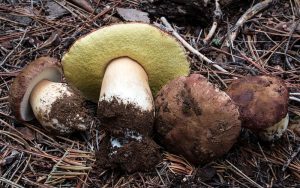
Spring King Boletes, photo by Michael Wood, from mykoweb.com
5. Spring King Bolete aka Porcini (Boletus rex-veris). Porcinis are a staple in Italian cuisine. The Spring King was thought to be an early-fruiting variant of Boletus edulis (King Bolete) until 2008, when it achieved its own unique status. E. rex-veris are usually found at high elevations (above 4,000 feet, or a few hundred feet below the snowline) in May and June, dovetailing nicely into King Bolete season, which occurs in late summer and early autumn. According to UBC’s Zoology department: “All Boletus species with a brown cap and a light stem with a network on it (sometimes subtle), and no colour changes to red or blue when cut or with age are considered good edibles (from https://www.zoology.ubc.ca/~biodiv/mushroom/B_rex-veris.html).” Network meaning, a fishnet pattern on the stem (note – mushroom stems are technically called a stipe, if we’re being proper). I must confess, I have never found a Spring King Bolete myself, the ones I’ve found have been only in late summer. Despite my lack of personal experience with this one, I think it is a good one to know about when planning a Spring forage.
Thanks for reading! This article is not intended to be an identification guide. Much of the information in this post has been gathered by myself over years of conferring with various books, websites, and resources, and my own personal experience and that of trusted friends. Unless specifically cited, please consider this post to be informed with experiential and “common” knowledge that I hope you will find interesting and inspire you to do your own research. When consuming any wild mushroom for the first time, be 100% certain of the ID, cook well, try a very small amount, do not consume with alcohol, and save one specimen in case you need to go to the emergency room so poison control can identify what you ate (I’m serious).
